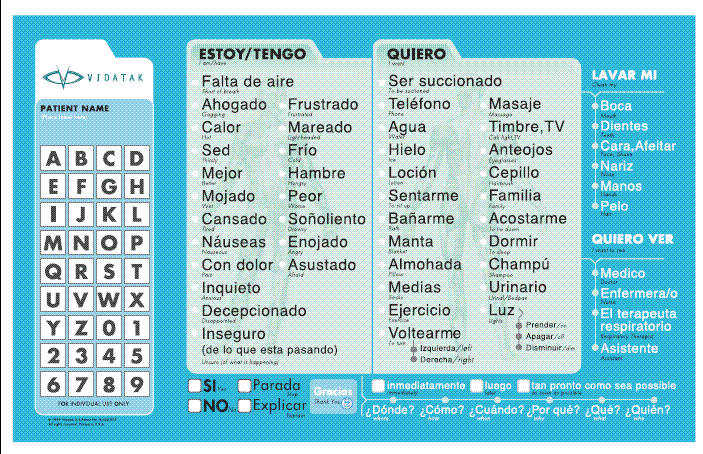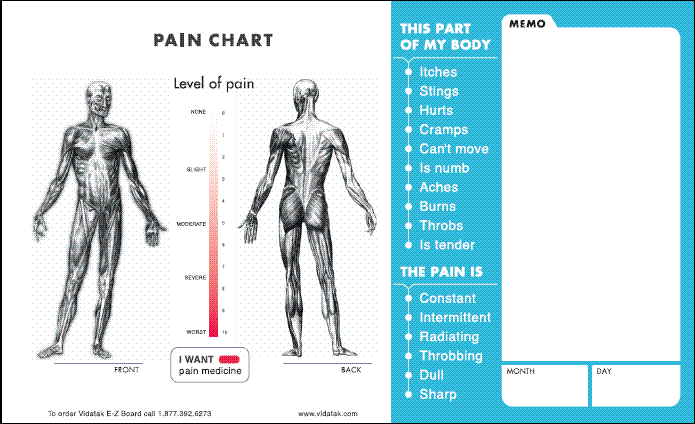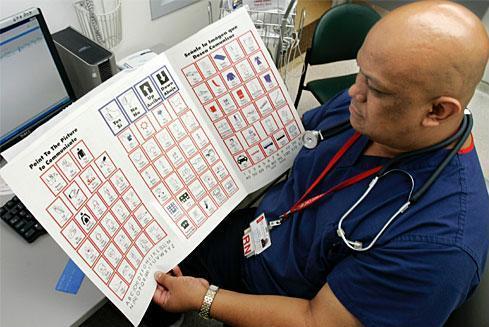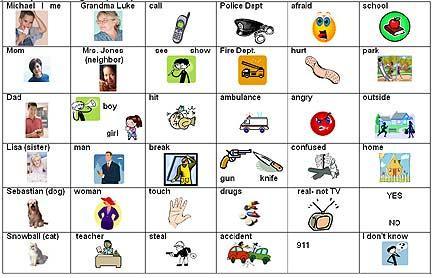Disaster Preparedness Tips for Emergency Management Personnel:
Communication Access for People with Limited Speech
To download a PDF of Disaster Preparedness Tips for Emergency Management Personnel:Communication Access for People with Limited Speech, click here.
|
People with limited speech are an especially vulnerable population in any emergency or disaster. This document provides information about communication methods for people who are not able to use their natural speech to communicate. This may include people with speech disabilities, individuals with cognitive difficulties, very young children, anyone under severe stress, people with significant hearing loss or anyone with limited English proficiency. Most emergency personnel are not adequately prepared to communicate with people who are unable to rely on their natural speech. Some simple methods can help provide effective communication access.
|
People who are unable to walk independently need their wheelchairs/scooters, walkers. |
Disaster Preparedness Tips For Emergency Management Personnel
5. Do you have, or does your facility provide, communication displays for people who are unable to be understood using their natural speech? If NO, click here.
1. Communicating with people who have limited speech
In every community, there are children and adults who are unable to speak so others can understand them. Being unable to communicate using one’s natural speech during any emergency or disaster makes someone especially vulnerable.
Augmentative and alternative communication (AAC) refers to a variety of methods that allow people to communicate when speech is limited.
|
1. Alphabet boards. Letters and words on a board that a person can point to and make words and sentences.
|
4. Alphabet boards. Letters and words on a board that a person can point to and make words and sentences. 5. Communication displays with pictures. Pictures and symbols on a board/display/book that a person can use to express thoughts, feelings, ask questions, etc. 6. Speech generating devices. Electronic devices that produce speech output (talk) when a person selects letters, words, pictures or symbols.
|
2. Communicating with someone whose speech is limited
Begin by identifying basic communication methods
(pay attention to pointing, gestures, nods, sounds, eye gaze and eye blinks)
- Say, “Show me how you say YES.”
- Say, “Show me how you say NO.”
- Say “Show me how you point to something or someone you want.”
- Always repeat the person’s actions and/or what they tell you to confirm that you have understood.
- Ask questions one at a time and ask questions that can easily be answered.
- Give the person extra time to respond.
- Take time to listen carefully.
NOTE: You can also suggest a way and teach people how to indicate other things (e.g., “I don’t know”; “Please repeat”; “I don’t understand”).
IMPORTANT: Some (NOT ALL) people with limited speech also have difficulty understanding what people say to them because of their disability, age, a hearing loss, cognitive difficulties and/or language differences. If you suspect this is a problem, try using pictures, and ask the same basic questions during an emergency situation.
After the mode is identified, ask a few basic questions.
1. “Is there someone here who can help me communicate with you? “
2. “Do you have a communication board or book or a speech generating device?”
3. “Did you bring it with you?”
|
Example: To identify the source of a person’s pain. . . Say, “Do you feel any pain?” When the person responds, (e.g., YES), confirm you have understood. Say, “You told me YES, you are in pain.” Then ask, “Where is your pain?” WAIT. If the person cannot point with a finger, hand or eyes, you can introduce a communication display (see right). Say, “When I touch the part of the picture where your body hurts, tell me YES.” Going slowly, begin pointing to the picture. Watch carefully to see when the person indicates the location of the pain. Confirm. Say, “Are you telling me you feel pain in your chest?” |
.jpg) |
This basic communication method can be used to identify the pain, hunger, physical and emotional needs of individuals who are unable to speak clearly.
3. Speech Generating Devices (SGDs)
 |
Figure 2. The famous physicist, Dr. Stephen Hawking, gives speeches around the world using an SGD. Here he converses with Ms.Ana Berlowitz after his lecture at Stanford University. Ms. Berlowitz uses a infrared head pointer and Dr. Hawking uses his finger to activate a switch so they can access language on their individual SGDs. |
Over a million individuals (young and old) use speech generating devices (SGDs). These are computers with special software that “talk.” They come in many different sizes and shapes. People who have significant communication disabilities use them to express their feelings, ask and answer questions, communicate basic needs, talk on the phone, lecture, have conversations, send email, and so on.
To communicate, the person simply selects words, pictures, letters or symbols with a finger or infra-red pointer, head stick, or switch and the device then “speaks” the message. For example, “It is a pleasure to meet you.“
Other equipment is often required in order for people to use SGDs (e.g., batteries, switches, mounts, carrying case). SGDs are electronic devices; they require that batteries be regularly recharged. Some varieties are low-cost with only a few available messages. However, many others are quite complex, costing $8,000 or more. These allow individuals to say anything they want. See Figure 3 below.
Note: People who rely on SGDs also use non-electronic communication displays, gestures and some limited speech with family and friends, but require SGDs to communicate with most other people.

.jpg)
Figure #3. Examples of speech generating devices (SGDs) that enable people with limited speech to ‘talk.’
4. Personal communication displays/boards/books.
Non-electronic communication displays/boards/books come in many shapes and sizes. Some products are commercially made and can be modified for personal use. However, most of these are customized by clinicians in consultation with the individuals who use them.
The examples in Figure 4 below show a variety of communication boards, books and displays. Some are used to communicate during a particular event or in a specific location (such as a restaurant or church).
Others are more generic and are used everywhere (like the alphabet board below). People may use one or more of this type.
NOTE: When someone is unable to point because of their disability, a communication partner or assistant can point to/scan their board for them (e.g., point to the pictures and words on their display and watch for what they choose).
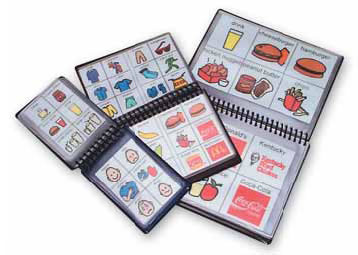




Figure 4. Communication books, boards and displays enable people to point to pictures, symbols, the alphabet, numbers, words and phrases. If individual is unable to point, partners can scan the board so they can construct messages. Some displays/boards/books have multiple purposes; others are specific to one event or location.
5. Emergency-oriented Communication Displays
Communication displays are being used in emergency rooms, ambulances, ICUs, refugee camps, and in other emergency settings. These tools can help solve communication problems and support people who have difficulty speaking because of a disability, their age, confusion, and so on. Examples of some are shown below.
Figure 5. This display has letters and numbers, as well as important symbols related to health care. It is a bilingual communication display (English and Spanish) and is also useful if someone is unable to read. (Mayer Johnson) Figure 6. This display is specifically designed for use in a hospital by someone who can read.(Vidatek)
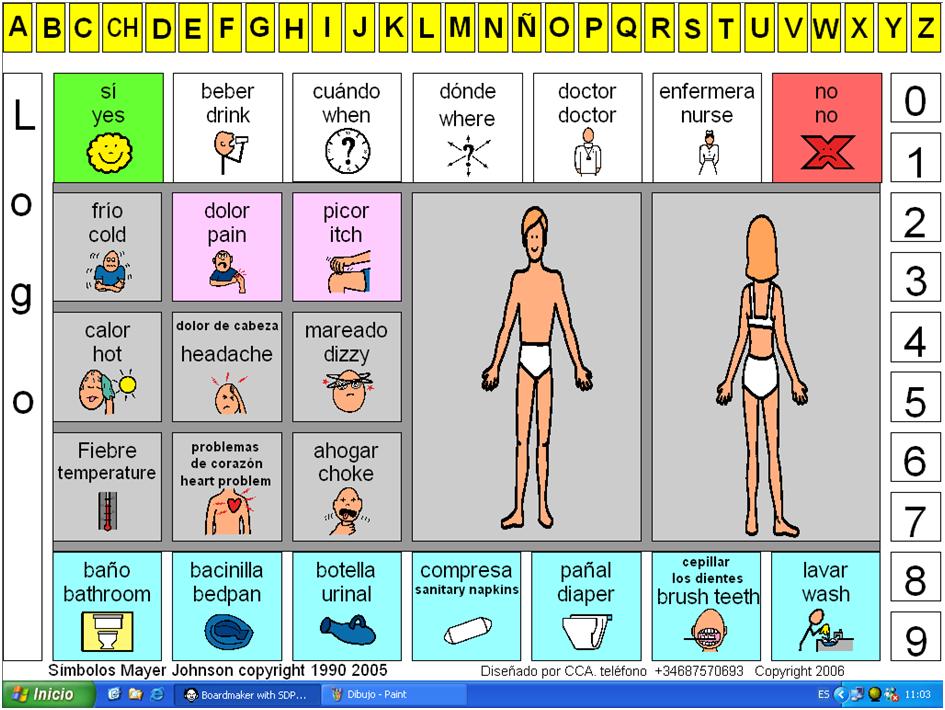

|
|
|
|
Figure 7. This is a bilingual/Spanish version of the |
Figure 8. This display is on the reverse side of displays Figure 6 and 7. It helps emergency personnel determine the degree and location of pain. (Vidatek) |
|
|
Figure 10. This display is designed for emergency personnel. There are smaller versions for use in ambulances, etc. (Michael Wescott, EAD Associates) |
|
|
Figure 11. This display was developed for someone with autism to help communicate about a crime. (Beverly Vicker, 2007)
To download a PDF of Disaster Preparedness Tips for Emergency Management Personnel: Communication Access for People with LImited Speech, click here. |
To download a PDF of Disaster Preparedness Tips for Emergency Management Personnel:Communication Access for People with Limited Speech, click here.

